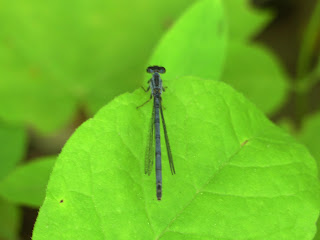Eastern Forktail
Though some of the larger damselflies (like the Ebony Jewelwing) are easy to spot by anyone paying attention, I'll frequently see some smaller ones like this Eastern Forktail. Unfortunately the small size of most forktails makes it easy to lose sight of them, especially when they're not moving. They get the forktail name because for most of these species the males have a slightly forked tip at the end of their abdomens but given their small size this characteristic probably won't be easily spotted if you run across one.
This is a heteromorphic female forktail, which my field guide [1] defines as a "dull morph in female odonates with 2 color morphs". Some other Eastern Forktails are considered andromorphic, defined as "bright (usually male-like) morph in female odonates with 2 color morphs". These terms are apparently only used when females have 2 different morphs; if a species has no colorful morph in the females they aren't all called heteromorphs, and if it has no dull morph females they aren't all called andromorphs.
It's unclear to me whether the heteromorphic/andromorphic terms are used the same way for other insects. I've never heard of them used to describe the 2 morphs of female Eastern Tiger Swallowtails, for example. Perhaps this coloration issue occurs more often in dragonflies/damselflies than in butterflies/moths, and so odonatologists coined the term?
 |
| May 26, 2022 at Washington Valley Park Photo 205018667, (c) jpviolette, some rights reserved (CC BY-NC) |
[1] Dragonflies and Damselflies of the East - Dennis Paulson



Comments
Post a Comment